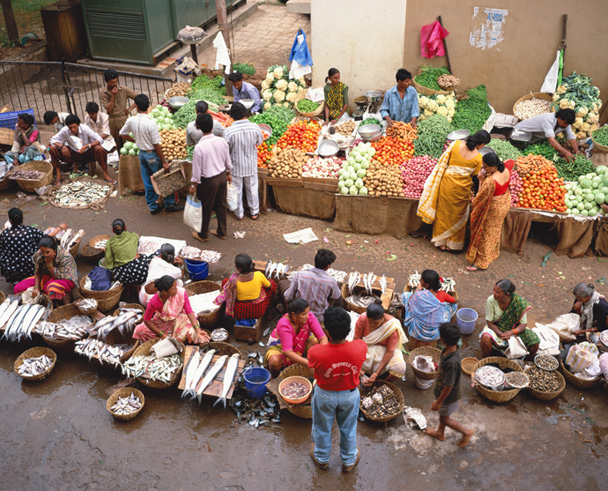India never ceases to take my breath away. Unknown culinary worlds within worlds are forever revealing themselves, perhaps just to keep me humble. On my last trip to India, it was the cooking of the Konkan Coast, a lush, tropical paradise curving down India’s western coastline that caught and held my attention. This region, starting around Mumbai and going south through Goa and Mangalore, stopping just north of Kerala, has been endowed generously by nature. On one side sits the palm-lined beaches fronting the Arabian Sea, rivaling those in the Maldives. As the land rises up to the hills known as the Western Ghats, there are rice fields, orchards, and rain forests producing all manner of mushrooms, breadfruit, and jackfruit.
Its culinary traditions are based entirely on local produce. The freshest of Arabian Sea fish—from the flat, serpentine Bombay duck (bombi) to the meaty pomfret, the plump mackerels (bangra), and gorgeous “white salmon” (rawas)—are pulled from the sea daily and end up on most household tables. Mushrooms from the rain forests, wholesome rices—many with their red hulls left partially on—extra-sweet coconuts and other superb fruit, including the word-famous Alphonso mango, and a plethora of divine vegetables from round green eggplants to pumpkin flowers, are used daily in the kitchens.
I had discovered Konkani food mostly in private homes in beach towns like Alibag and in small seaside cafés of dubious cleanliness all along the coast. Most tourists have had little access to this regional Indian cuisine except in a few second-tier Mumbai restaurants.
But now, with the opening of Konkan Café in Mumbai’s swank Vivanta by Taj-President Hotel (ask your taxi driver for the old President Hotel) all this has changed. Under the exacting guidance of chef Ananda Solomon, the restaurant serves a full range of Konkani delicacies. Many will come as a very pleasant surprise to visitors.
The restaurant itself is not a re-creation of a Mangalorean home but an actual Mangalorean home bought whole and shipped in pieces to be reassembled and transformed into a restaurant. The chef brought the windows, the wooden pillars, the chairs, and even the utensils and kitchen measures, which he uses for decoration on the ocher walls.
At the entrance, you may stop and watch a pancake being prepared—neer dosa (or “water” pancake as the rice batter is so thin). I love this sensual pancake with a passion. It may be best described as a large, crinkly, folded-up pancake with the same slithery, satiny texture as wide rice noodles.
We settle ourselves down at the table and start with solkadi, a cooling drink made with coconut milk and the semi-dried purplish skin of kokum, a sour, mangosteen-like fruit. With hints of chile, mustard seed, and curry leaves, it is so good we want more but stop, as we know a feast awaits. It would be impossible to reproduce this dish outside the Konkan region: The coconuts are brought in from Mangalore where they are known for their sweet juiciness. And the kokum is still soft and purple, infusing the drink with the loveliest pink coloring.
Next come a mound of crisp, unrecognizable papars (pappadams), handmade from rices, millets, and split peas and dried in the sun before roasting or frying. There is even a black pappadam made from ragi, or finger millet. All these are to be eaten with a large selection of pickles and chutneys. There is a red chutney made from roasted dried red chiles, grated coconut, and a bit of fresh, seasonal, liquid jaggery (unrefined brown sugar); a roasted green tomato chutney; a green chile pickle, small pickled onions; and rain forest mushrooms pickled with a paste of palm vinegar, chiles, tomatoes, cinnamon, and cloves. We dip and eat with pleasure.
We order vegetarian thalis (stainless steel platters that come lined with banana leaves), as we want to try all the creepers and greens we have seen in Konkani markets. The dishes here include red amaranth rice stir-fried with soaked and boiled mung beans (lal math sukhe), as many vegetables are cooked with boiled or sprouted beans for taste, texture, and added nutrition; there is a lovely combination of dill and red sorrel (shepu ambat chuka ani matha chi chatan bhaji); a cauliflower and green pea upkari (a dry stir-fry) in which the vegetables are sautéed with mustard seeds, garlic, broken red chiles, and shallots; as well as basale gassi, a curry made from a delicious thick-leaved green that had caught my eye at the morning bazaar. We eat these with the neer dosa and roasted rice flatbreads (bhakris).
We order fried fish and fish curries, as the Konkanis do these so perfectly. Before frying, the fish are generally marinated in a red paste made with special red bedgi chiles that have bright color but medium heat, tamarind juice, garlic, cumin, and coriander, then dipped lightly in semolina and fried. For our curry, we try prawns with green mango, a prawn gassi, Mangalorean-style. Hot with green chiles and tart with the green mango, we devour this with red rice, the fat-grained, partially milled variety for which this coast is so well known. We are in heaven.
We have no room for dessert, but those who do must try the Goan layered cake, bebinca. Built up very slowly, it is really a stack of pancakes traditionally baked over and then under coconut husk embers. A thin batter—coconut milk, egg yolks, and melted jaggery—is poured into a pan to form one pancake. When it is almost done, a second pancake is formed on top of the first, with the heat coming from the top. And so it goes for hours, one patient pancake at a time until there is a whole, almost caramelized, cake. It is one of the many wonders arising from the magical Konkan coast.
Madhur Jaffrey is an award-winning actress, a cookbook author with six James Beard Awards, winner of a journalism award from the IACP, TV chef, and member of the James Beard Hall of Fame.

